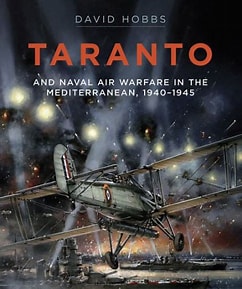
Taranto; and Naval Air Warfare in the Mediterranean, 1940-1945. By David Hobbs. Seaforth Publishing, Barnsley, Yorkshire, 2020.
Reviewed by Tim Coyle
‘Taranto was the supreme justification for the Fleet Air Arm for it was the first time in history that an enemy fleet had been defeated without ever sighting or engaging the opposing ships’, so read the menu for the Taranto Anniversary Dinner at RNAS Yeovilton in 1973. Operation Judgement – the FAA strike on the Italian Navy fleet anchorage at Taranto – sank and disabled three battleships and two cruisers on 11 November 1940. Twenty-one Fairey Swordfish torpedo bombers, flying from HMS Illustrious, gave strength to the advocates of naval air power and arguably saw the beginning of the battleship’s demise.
Taranto had an even greater ramification beyond the satisfaction enjoyed by RN FAA members and supporters. Imperial Japanese Navy aviators studied the Taranto raid and developed the tactics executed on 7 December 1941 at Pearl Harbor.
David Hobbs adds to his suite of FAA histories in this definitive work on Taranto and Naval Warfare in the Mediterranean 1940-1945. Hobbs is well-known for his published works and, to Australian Naval Institute members, as a prolific contributor to ANI book reviews. As a 30-year naval aviator, Hobbs adds a specialist’s input to the FAA historical record, analysing Admiralty and government policies and decisions, aircraft carrier and naval aircraft design and operations, logistics, personnel and training, sourced from official records and extensive secondary sources.
As the book title implies, it is far more than a treatise on Taranto, important though this raid was. It covers the whole of FAA participation in the Mediterranean theatre – the Battle of Matapan, Force H and the reinforcement of Malta, the Pedestal Convoy, Operation Torch, the Allied invasion of Sicily and Italy and Operation Dragoon. FAA aircraft operated ashore from rudimentary airstrips and, apart from naval-specific aviation applications, became proficient in joint force operations such as close air support to land forces. In 25 operations over 26 months, six RN carriers ferried 746 RAF fighters to flying off positions from Malta for the island’s defence.
The FAA Mediterranean operational history is all the more significant given its dismal experience from 1918 to 1937 under the dank hand of the RAF. Air Force leaders believed strategic bombing was the panacea for future wars and, consequently, naval aircraft design languished. With the FAA’s restoration to full Admiralty control it still took until 1944 for the FAA to be equipped with first rate naval-specific aircraft – and these were largely American. Despite this, the British-designed, and quasi-obsolete aircraft performed outstandingly in the hands of ‘hostilities only’ RN Volunteer Reserve aircrew and maintainers. Among those who championed naval airpower and better aircraft were not aviators but executive officers who had commanded aircraft carriers and formed an appreciation of their aircrews’ capabilities.
Surprisingly, the FAA that carried out these operations was comparatively quite small. Hobbs provides appendices showing planned and actual front-line aircraft strength 1939-1944. In September 1939, actual aircraft numbers of all types were 232. By December 1944 planned numbers were 1605 planned and approximately 1300 actual. Aircrew comprised 1806 pilots, observers and telegraphist/air gunners in September 1939 and 11445 in July 1944.
The thread running through the book is the flexibility of naval airpower and its ability to strike and move on, with its organic logistics train. The argument was won by 1945, exemplified by the Mediterranean campaign and the Pacific war; however, the ‘carrier debate’ continues to this day. Now carriers themselves are again under question in the light of Anti-Access/Area Defence (‘coastal defence’ to traditionalists) and long-range hypersonic missiles. Regardless, David Hobbs has provided a meticulously researched and expertly told operational history of the FAA in the Mediterranean. Highly recommended as a major contribution to overall air power history.



